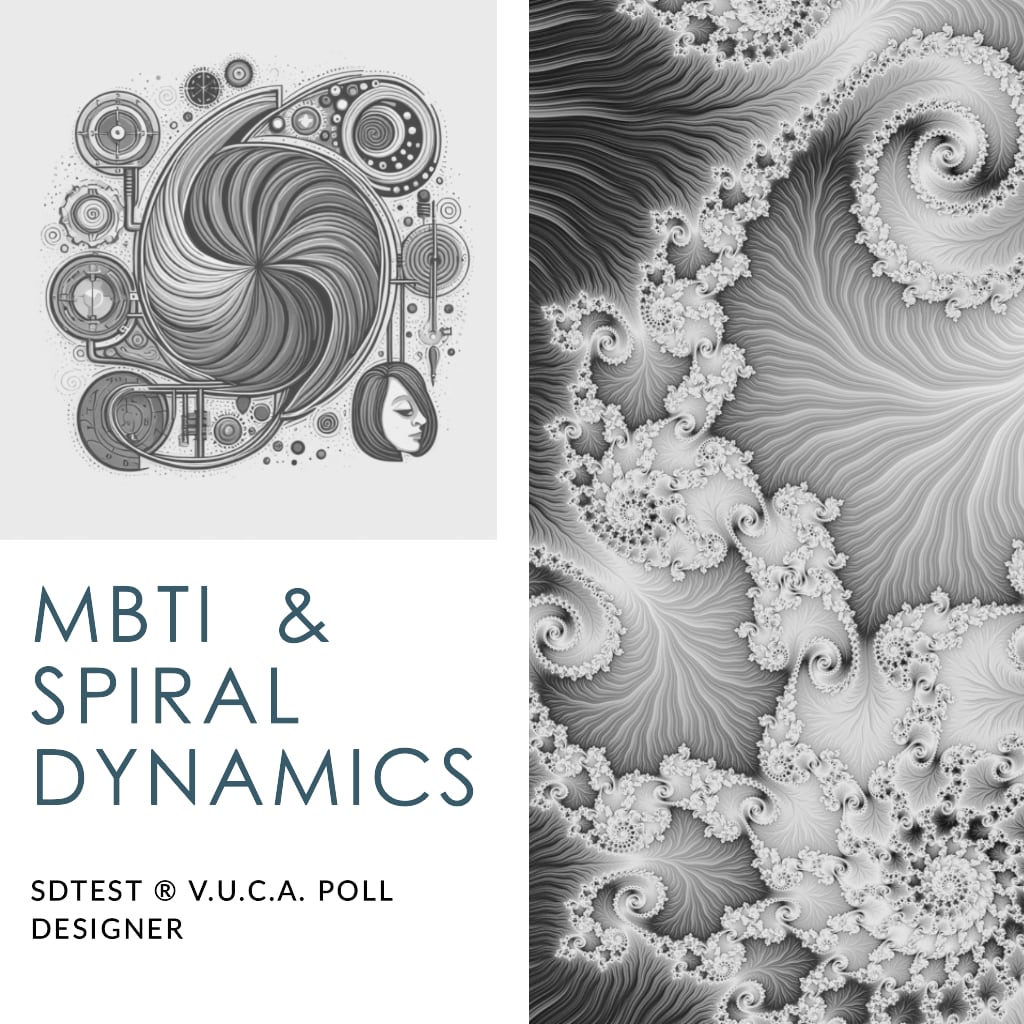
We received this question after the publication of articles Simple SDTEST® Gives Great Possibilities and Mathematical Psychology. The Myers-Briggs Type Indicator (MBTI®) and Spiral Dynamics are two systems that categorize personality traits and motivational values, respectively. This article is dedicated to answering this question. It will show with a real example how to use the SDTEST® V.U.C.A. poll designer.
MBTI® categorizes personality into 16 types based on preferences across four dichotomies: Extraversion/Introversion, Sensing/Intuition, Thinking/Feeling, and Judging/Perceiving. It has been extensively validated and applied in career development, leadership, and team-building.
Spiral Dynamics maps the evolution of motivational value systems in a spectrum of colors or levels, from basic survivalist Beige to holistic-minded Turquoise. It builds on Clare Graves' theory of levels of human existence and has been used extensively in organizational development and coaching. SDTEST® has 86442 results from 171 countries, results clustered into 7998 unique motivational patterns.
While both systems group people into "types", MBTI® reflects non-hierarchical preferences while Spiral Dynamics depicts hierarchical development.
Some relationships could potentially be theorized between MBTI® types and Spiral levels based on apparent similarities in focus:
So Intuitive, Feeling types like INFJ could speculatively be associated with later Green and Yellow Spiral levels, while Sensing, Thinking types such as ISTJ fit earlier Blue and Orange levels.
Studying the correlation between Spiral Dynamics developmental stages and MBTI® personality types could potentially yield some useful insights, but it also has limitations:
Intriguing connections may emerge, directly linking MBTI® types to Spiral Dynamics levels.
The SDTEST® V.U.C.A. poll designer is as simple as Google Forms. Watch this two-minute video to get acquainted and compare. The main difference of the SDTEST® V.U.C.A. poll designer is the presence of an independent multilingual UI for changing the site language and poll form. If, for example, your primary site language is English, and you do the poll in 6 international UN languages, then you only need to use the language change window for the poll form. If you are doing this work together with colleagues whose primary language is Arabic, Chinese, Spanish, German, French, or other languages, then for their convenience, they can change the language of the site.
Now you know the functionality of the Designer, and you can create your own, for example, MBTI®.
We invite you to look “under the hood” of the poll Psychological Wellbeing (by Carol D. Ryff) we have already created. Developed by psychologist Carol D. Ryff, the 42-item Psychological Wellbeing (PWB) Scale. Source: Ryff, Carol D., Psychological Well-Being Revisited: Advances in Science and Practice, NIH Public Access, Psychother Psychosom, Vol.83, No.1, Pp.31, (2014). Watch the next two-minute video.
Now you need to share the link to your survey, and survey participants choose the language in which they are comfortable answering the questions. Watch the next one-minute video.
| Serangan |
Kabeh patarosan
Kabeh patarosan 1) Otonomi (sabaraha anjeun satuju atanapi henteu satuju?) 2) Perancis lingkungan (sabaraha anjeun satuju atanapi henteu satuju?) 3) Tumuwuh pribadi (sabaraha anjeun satuju atanapi henteu satuju?) 4) Hubungan positip sareng batur (sabaraha anjeun satuju atanapi henteu satuju?) 5) Tujuan dina kahirupan (sabaraha anjeun satuju atanapi henteu satuju?) 6) Ditampi diri (sabaraha anjeun satuju atanapi henteu satuju?) |
|||||||||||||
| Sebaran |
|
|||||||||||||
| Normal |
|
|||||||||||||
| Normal |
|
|||||||||||||
| Normal |
|
|||||||||||||
| Normal |
|
|||||||||||||
| Normal |
|
|||||||||||||
| Nonnormal |
|
|||||||||||||
| Normal |
|
|||||||||||||

Exploring correlations between the two systems, MBTI® and Spiral Dynamics, could provide additional insights into motivational development and personality.
However, deriving such integrative insights requires avoiding simplistic stereotyping, acknowledging limitations in current Spiral Dynamics validation, and recognizing that personality and values are multi-faceted within individuals. If these complexities are accounted for, exploring potential connections between the frameworks could yield a more textured perspective on the interplay between personality type, values, and consciousness development over the lifespan. However, this endeavor requires extensive additional research and cautious interpretation.
r = 0.8–0.9r \approx 0.7r \approx 0.3–0.5In summary, while the MBTI® personality typology and Spiral Dynamics developmental spectrum offer distinct lenses, exploring their potential connections could yield additional insights. Observing how motivational values interact with personality preferences at different stages may provide a more multifaceted view of individual differences. However, directly coupling the two frameworks oversimplifies their nuances.
Each system has a different purpose and validation base. Individuals express multifaceted personalities and multi-layered values that resist rigid mapping between categories. Stereotyping risks must also be avoided. If these complexities are recognized, judiciously analyzing relationships between the two systems could contribute to a more textured understanding of personality and consciousness development. However, further research and careful interpretation are required to derive meaningful integrative insights from correlations.
An open and nuanced exploration of how motivational development interplays with personality types, without forcing definitive linkages, may offer complementary perspectives that enrich our comprehension of the psychology of individual differences. This endeavor promises intellectual rewards but requires diligence in acknowledging both frameworks' limitations and avoiding oversimplification. With care, synergies between them may help capture a fuller portrait of diversity in personality and values.
